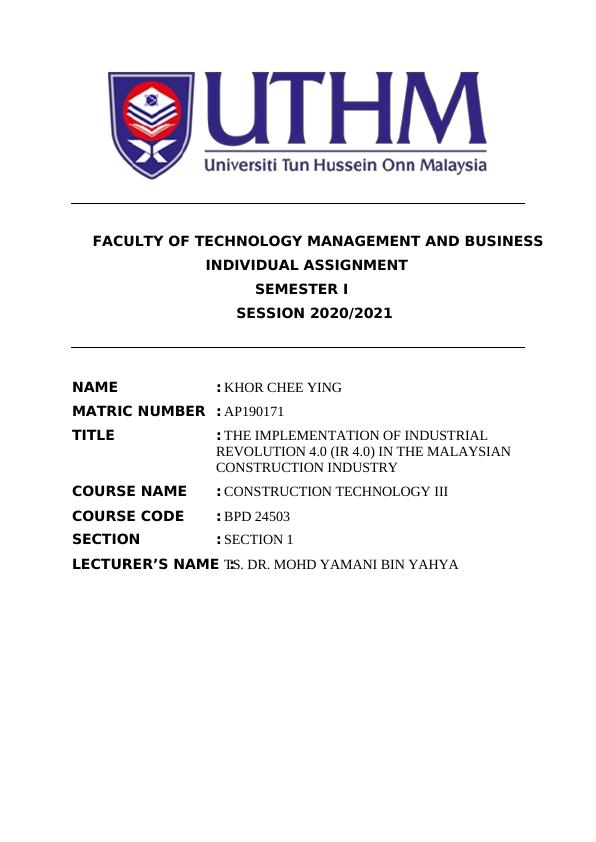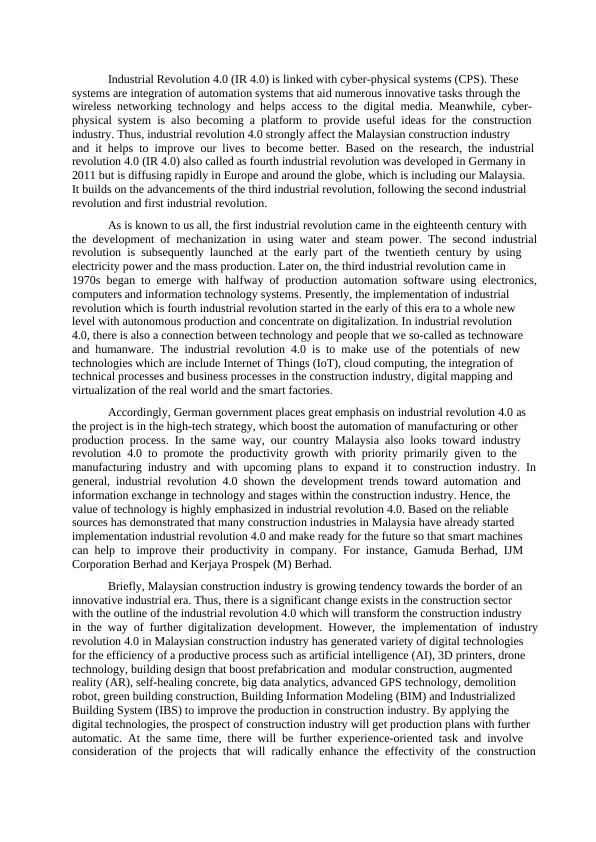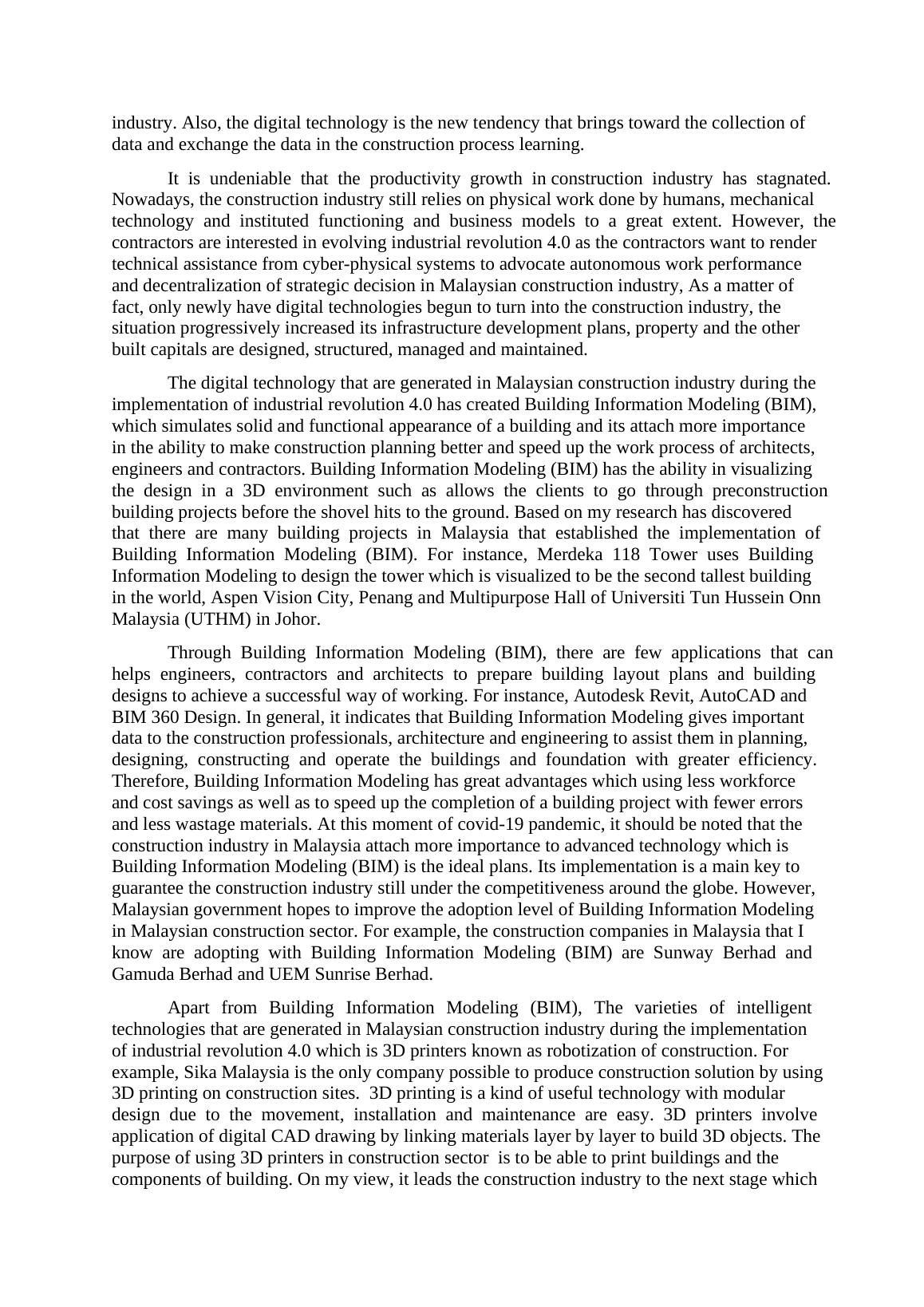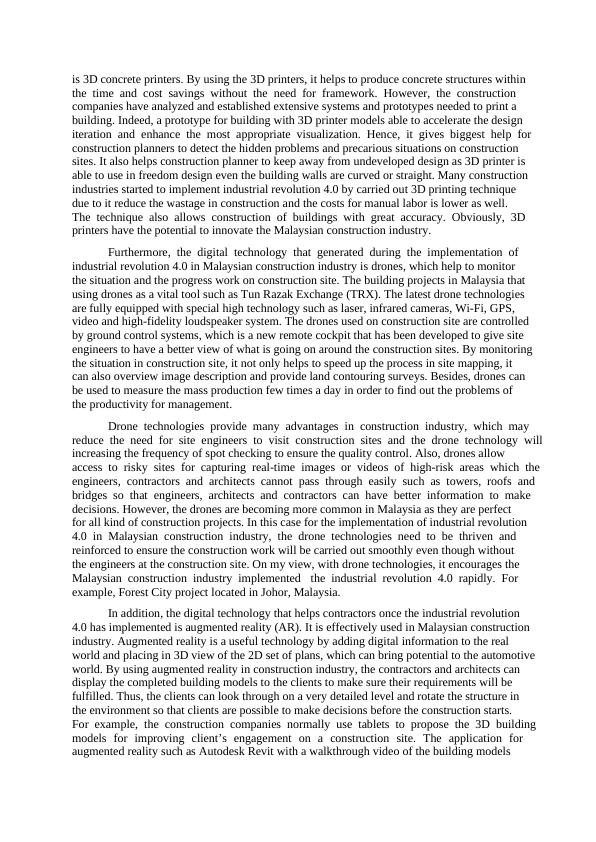Industrial Revolution 4.0 (IR 4.0) in the MALAYSIAN CONSTRUCTION INDUSTRY
13 Pages7460 Words76 Views
Added on 2021-05-11
About This Document
Based on the research, the industrial revolution 4.0 (IR 4.0) also called as fourth industrial revolution was developed in Germany in 2011 but is diffusing rapidly in Europe and around the globe, which is including our Malaysia. Based on the research, the industrial revolution 4.0 (IR 4.0) also called as fourth industrial revolution was developed in Germany in 2011 but is diffusing rapidly in Europe and around the globe, which is including our Malaysia.
Industrial Revolution 4.0 (IR 4.0) in the MALAYSIAN CONSTRUCTION INDUSTRY
Added on 2021-05-11
ShareRelated Documents
FACULTY OF TECHNOLOGY MANAGEMENT AND BUSINESS INDIVIDUAL ASSIGNMENT SEMESTER I SESSION 2020/2021 NAME : KHOR CHEE YINGMATRIC NUMBER : AP190171 TITLE : THE IMPLEMENTATION OF INDUSTRIAL REVOLUTION 4.0 (IR 4.0) IN THE MALAYSIAN CONSTRUCTION INDUSTRY COURSE NAME : CONSTRUCTION TECHNOLOGY IIICOURSE CODE : BPD 24503 SECTION : SECTION 1LECTURER’S NAME : TS. DR. MOHD YAMANI BIN YAHYA

Industrial Revolution 4.0 (IR 4.0) is linked with cyber-physical systems (CPS). These systems are integration of automation systems that aid numerous innovative tasks through the wireless networking technology and helps access to the digital media. Meanwhile, cyber-physical system is also becoming a platform to provide useful ideas for the construction industry. Thus, industrial revolution 4.0 strongly affect the Malaysian construction industry and it helps to improve our lives to become better. Based on the research, the industrial revolution 4.0 (IR 4.0) also called as fourth industrial revolution was developed in Germany in 2011 but is diffusing rapidly in Europe and around the globe, which is including our Malaysia. It builds on the advancements of the third industrial revolution, following the second industrial revolution and first industrial revolution. As is known to us all, the first industrial revolution came in the eighteenth century with the development of mechanization in using water and steam power. The second industrial revolution is subsequently launched at the early part of the twentieth century by using electricity power and the mass production. Later on, the third industrial revolution came in 1970s began to emerge with halfway of production automation software using electronics, computers and information technology systems. Presently, the implementation of industrial revolution which is fourth industrial revolution started in the early of this era to a whole new level with autonomous production and concentrate on digitalization. In industrial revolution 4.0, there is also a connection between technology and people that we so-called as technoware and humanware. The industrial revolution 4.0 is to make use of the potentials of new technologies which are include Internet of Things (IoT), cloud computing, the integration of technical processes and business processes in the construction industry, digital mapping and virtualization of the real world and the smart factories. Accordingly, German government places great emphasis on industrial revolution 4.0 as the project is in the high-tech strategy, which boost the automation of manufacturing or other production process. In the same way, our country Malaysia also looks toward industry revolution 4.0 to promote the productivity growth with priority primarily given to the manufacturing industry and with upcoming plans to expand it to construction industry. In general, industrial revolution 4.0 shown the development trends toward automation and information exchange in technology and stages within the construction industry. Hence, the value of technology is highly emphasized in industrial revolution 4.0. Based on the reliable sources has demonstrated that many construction industries in Malaysia have already started implementation industrial revolution 4.0 and make ready for the future so that smart machines can help to improve their productivity in company. For instance, Gamuda Berhad, IJM Corporation Berhad and Kerjaya Prospek (M) Berhad. Briefly, Malaysian construction industry is growing tendency towards the border of an innovative industrial era. Thus, there is a significant change exists in the construction sector with the outline of the industrial revolution 4.0 which will transform the construction industry in the way of further digitalization development. However, the implementation of industry revolution 4.0 in Malaysian construction industry has generated variety of digital technologies for the efficiency of a productive process such as artificial intelligence (AI), 3D printers, drone technology, building design that boost prefabrication and modular construction, augmented reality (AR), self-healing concrete, big data analytics, advanced GPS technology, demolition robot, green building construction, Building Information Modeling (BIM) and Industrialized Building System (IBS) to improve the production in construction industry. By applying the digital technologies, the prospect of construction industry will get production plans with further automatic. At the same time, there will be further experience-oriented task and involve consideration of the projects that will radically enhance the effectivity of the construction

industry. Also, the digital technology is the new tendency that brings toward the collection of data and exchange the data in the construction process learning. It is undeniable that the productivity growth in construction industry has stagnated. Nowadays, the construction industry still relies on physical work done by humans, mechanical technology and instituted functioning and business models to a great extent. However, the contractors are interested in evolving industrial revolution 4.0 as the contractors want to render technical assistance from cyber-physical systems to advocate autonomous work performance and decentralization of strategic decision in Malaysian construction industry, As a matter of fact, only newly have digital technologies begun to turn into the construction industry, the situation progressively increased its infrastructure development plans, property and the other built capitals are designed, structured, managed and maintained. The digital technology that are generated in Malaysian construction industry during the implementation of industrial revolution 4.0 has created Building Information Modeling (BIM), which simulates solid and functional appearance of a building and its attach more importance in the ability to make construction planning better and speed up the work process of architects, engineers and contractors. Building Information Modeling (BIM) has the ability in visualizing the design in a 3D environment such as allows the clients to go through preconstruction building projects before the shovel hits to the ground. Based on my research has discovered that there are many building projects in Malaysia that established the implementation of Building Information Modeling (BIM). For instance, Merdeka 118 Tower uses Building Information Modeling to design the tower which is visualized to be the second tallest building in the world, Aspen Vision City, Penang and Multipurpose Hall of Universiti Tun Hussein Onn Malaysia (UTHM) in Johor. Through Building Information Modeling (BIM), there are few applications that can helps engineers, contractors and architects to prepare building layout plans and building designs to achieve a successful way of working. For instance, Autodesk Revit, AutoCAD and BIM 360 Design. In general, it indicates that Building Information Modeling gives important data to the construction professionals, architecture and engineering to assist them in planning, designing, constructing and operate the buildings and foundation with greater efficiency. Therefore, Building Information Modeling has great advantages which using less workforce and cost savings as well as to speed up the completion of a building project with fewer errors and less wastage materials. At this moment of covid-19 pandemic, it should be noted that the construction industry in Malaysia attach more importance to advanced technology which is Building Information Modeling (BIM) is the ideal plans. Its implementation is a main key to guarantee the construction industry still under the competitiveness around the globe. However, Malaysian government hopes to improve the adoption level of Building Information Modeling in Malaysian construction sector. For example, the construction companies in Malaysia that I know are adopting with Building Information Modeling (BIM) are Sunway Berhad and Gamuda Berhad and UEM Sunrise Berhad. Apart from Building Information Modeling (BIM), The varieties of intelligent technologies that are generated in Malaysian construction industry during the implementation of industrial revolution 4.0 which is 3D printers known as robotization of construction. For example, Sika Malaysia is the only company possible to produce construction solution by using 3D printing on construction sites. 3D printing is a kind of useful technology with modular design due to the movement, installation and maintenance are easy. 3D printers involve application of digital CAD drawing by linking materials layer by layer to build 3D objects. The purpose of using 3D printers in construction sector is to be able to print buildings and the components of building. On my view, it leads the construction industry to the next stage which

is 3D concrete printers. By using the 3D printers, it helps to produce concrete structures within the time and cost savings without the need for framework. However, the construction companies have analyzed and established extensive systems and prototypes needed to print a building. Indeed, a prototype for building with 3D printer models able to accelerate the design iteration and enhance the most appropriate visualization. Hence, it gives biggest help for construction planners to detect the hidden problems and precarious situations on construction sites. It also helps construction planner to keep away from undeveloped design as 3D printer is able to use in freedom design even the building walls are curved or straight. Many construction industries started to implement industrial revolution 4.0 by carried out 3D printing technique due to it reduce the wastage in construction and the costs for manual labor is lower as well. The technique also allows construction of buildings with great accuracy. Obviously, 3D printers have the potential to innovate the Malaysian construction industry. Furthermore, the digital technology that generated during the implementation of industrial revolution 4.0 in Malaysian construction industry is drones, which help to monitor the situation and the progress work on construction site. The building projects in Malaysia that using drones as a vital tool such as Tun Razak Exchange (TRX). The latest drone technologies are fully equipped with special high technology such as laser, infrared cameras, Wi-Fi, GPS, video and high-fidelity loudspeaker system. The drones used on construction site are controlled by ground control systems, which is a new remote cockpit that has been developed to give site engineers to have a better view of what is going on around the construction sites. By monitoring the situation in construction site, it not only helps to speed up the process in site mapping, it can also overview image description and provide land contouring surveys. Besides, drones can be used to measure the mass production few times a day in order to find out the problems of the productivity for management. Drone technologies provide many advantages in construction industry, which may reduce the need for site engineers to visit construction sites and the drone technology will increasing the frequency of spot checking to ensure the quality control. Also, drones allow access to risky sites for capturing real-time images or videos of high-risk areas which the engineers, contractors and architects cannot pass through easily such as towers, roofs and bridges so that engineers, architects and contractors can have better information to make decisions. However, the drones are becoming more common in Malaysia as they are perfect for all kind of construction projects. In this case for the implementation of industrial revolution 4.0 in Malaysian construction industry, the drone technologies need to be thriven and reinforced to ensure the construction work will be carried out smoothly even though without the engineers at the construction site. On my view, with drone technologies, it encourages the Malaysian construction industry implemented the industrial revolution 4.0 rapidly. For example, Forest City project located in Johor, Malaysia. In addition, the digital technology that helps contractors once the industrial revolution 4.0 has implemented is augmented reality (AR). It is effectively used in Malaysian construction industry. Augmented reality is a useful technology by adding digital information to the real world and placing in 3D view of the 2D set of plans, which can bring potential to the automotive world. By using augmented reality in construction industry, the contractors and architects can display the completed building models to the clients to make sure their requirements will be fulfilled. Thus, the clients can look through on a very detailed level and rotate the structure in the environment so that clients are possible to make decisions before the construction starts. For example, the construction companies normally use tablets to propose the 3D building models for improving client’s engagement on a construction site. The application for augmented reality such as Autodesk Revit with a walkthrough video of the building models

End of preview
Want to access all the pages? Upload your documents or become a member.
Related Documents
Management Practices for Industry 4.0 in the Service Sectorlg...
|19
|14735
|68
(PDF) The First Industrial Revolutionlg...
|10
|2805
|249
(PDF) Literature review of Industry 4.0lg...
|10
|2377
|306
Lean Six Sigma Assignment 2022lg...
|6
|993
|29
Fourth Industrial Revolution: Meaning, Characteristics, and Impactslg...
|6
|1473
|305
How the food industry adapt to industry 4.0lg...
|16
|3112
|80
